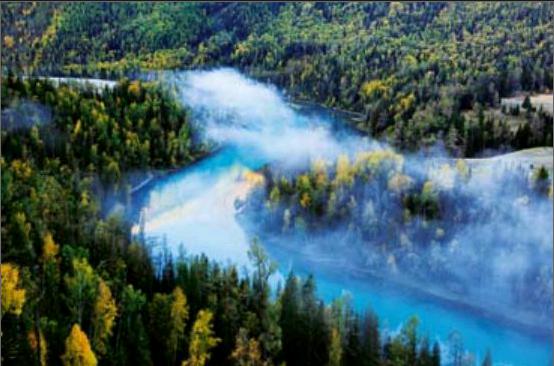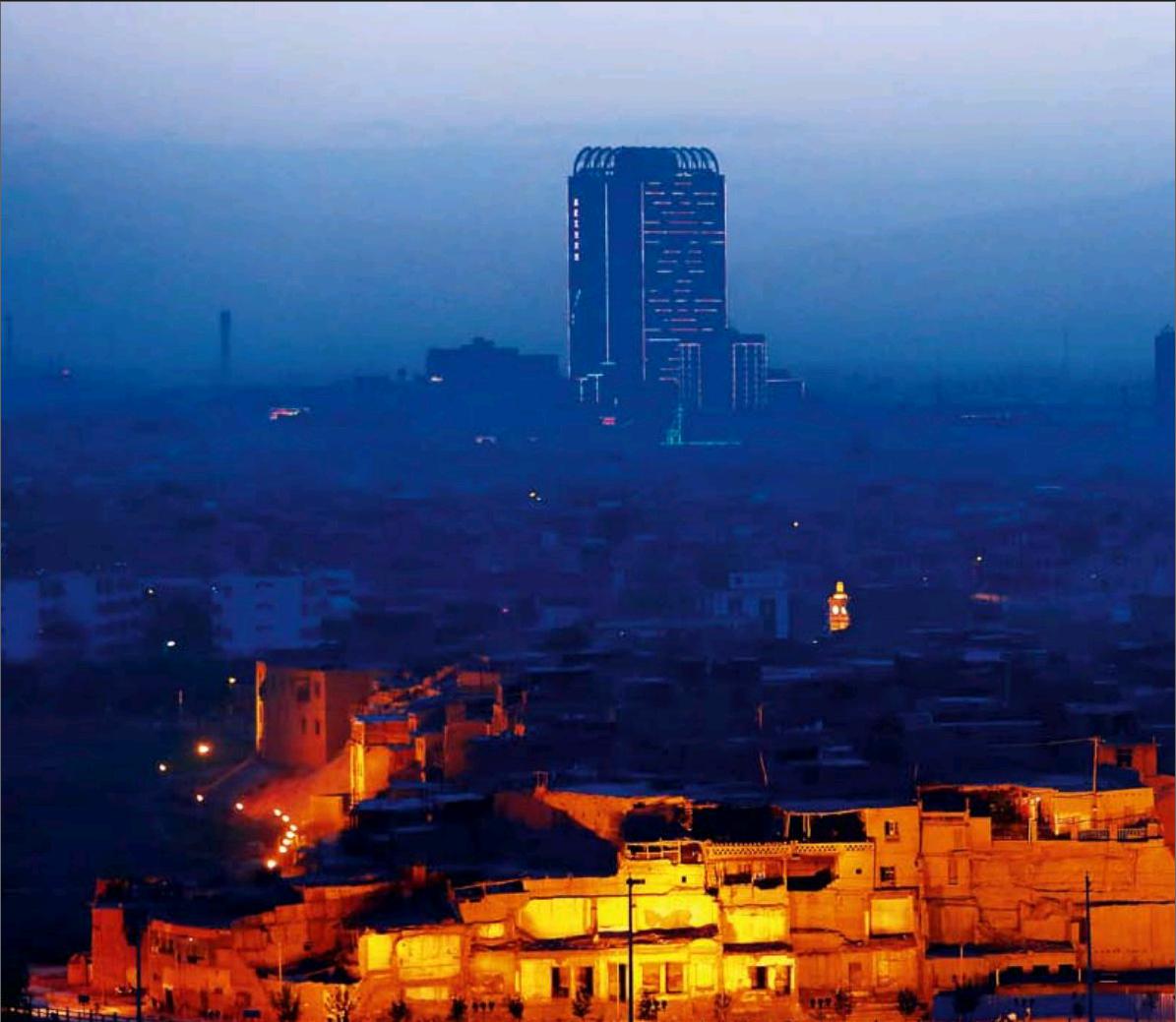A Tale of Four Cities
2014-07-28byWangQi
by+Wang+Qi



Urumqi: Diverse City
Viewed from atop a hill in Red Hill Park in Urumqi, capital of the Xinjiang Uygur Autonomous Region, the city hearkens to Beijing: Both feature towering skyscrapers, crisscrossing expressways, and multiple cloverleaf junctions. At dusk, lofty Bogda Peak of the Tianshan Mountains appears to catch fire as it is bathed in the final rays of the setting sun. Over centuries, Urumqi has enjoyed the shadows of the snow-capped peak, hinting that the already-modern city is far from as simple as it seems.
A stranger is unable to see deep into Urumqi with a glance from atop Red Hill. One must explore its streets and lanes, both modern and old. The signs of most roadside shops are written in both Chinese and Uygur. Newsstands sell newspapers in various languages that are unfamiliar to Han people, including Uygur, Mongolian, and Kazakh. A Uygur fruit vendor, after explaining the difference between Hami and Jiashi melons in fluent Mandarin, may turn to a companion with remarks in a completely unintelligible tongue.
Urumqi residents are no strangers to various ethnicities. Even in centuries past, it has been common in Urumqi for people of contrasting backgrounds to share food and drink while communicating in myriad languages – a rare scene in other parts of China.
However, after the July 5th Urumqi riot in which 197 were killed in 2009, local residents began to worry about their safety. After the incident, more than 8,000 surveillance cameras were installed in the citys streets, and community security teams began to patrol around the clock. Although social order has been restored in Urumqi, the aftermath lingers on.
Perhaps it would be improper to classify Urumqi residents by ethnicity. Regardless of language and ethnic group, all residents can be defined as Urumqiers, a group of people noted for their open-mindedness, hospitability, and kindness.
Shihezi: City of Plenty
Perhaps “spacious” is the best word to describe the city of Shihezi in northern Xinjiang.
City squares, roads, and even local hotel rooms are stunningly spacious. A saying goes that without visiting Xinjiang, one would not know how vast China is. Shihezi is a pristine representation of the proverb.
In a narrow sense, Shihezi is a new city that developed from an army farm. The area was previously a barren desert that was transformed into a man-made oasis. Shihezi is home to the headquarters of the No.8 Agricultural Division of the Xinjiang Produc-tion and Construction Corps. It has been cited as one of the worlds most livable cities by the United Nations.
Broadly defined, Shihezi includes 18 army farms in areas such as Mosuowan, Xiayedi, Paotai, and Chepaizi. Driving through its rural areas, one meets farmlands lining the highway extending to the foot of snowy mountains on the horizon. The vast oasis covers 7,681 square kilometers and has become one of Xinjiangs major producers of grain, cotton, and fruit. The majority of local farmers have adopted mechanized production.
Of every agricultural product in Shihezi, cotton is the most famous. Shihezi produces five percent of Chinas cotton. Today, the plastic mulch technique is widely used in cotton plantations around Shihezi. Through promoting the concept of precision agriculture, 85 percent of local farmland employs mechanization.
Burqin: Gods Rear Window
What can you see through the rear window of gods abode? Burqin has the answer.
Kanas Lake is nicknamed the back garden of gods. Most visitors fly to Kanas Airport and then reach the lake via Jiadeng Valley, but there is an alternative route: Set out from Habahe County and reach the lake via Baihaba Village.
A path of wooden planks stretches along the bank of Kanas Lake. On one side of the path is a dense Siberian taiga forest, and on the other side the lakes surface is as smooth as a mirror. Halat Mountain reaches skywards on the opposite bank of the lake. On the mountain is the famous Fish-Watching Pavilion. Some claim that you may witness never-before-seen creatures from the pavilion.
In late September, coniferous forests around the lake remain green, while birch leaves turn yellow and leaves of European aspens go red. Kanas Lake thus welcomes its most colorful season.
At 7:30 a.m., before the first rays of morning sun creep out, the three famous bays of Kanas Lake – Sleeping Dragon, Moon, and Immortal Bays – are already packed with tourists. Milky fog floats above the lake, and the grey sun resembles a full moon.
For local Tuvans and Kazakhs, the national 5A scenic area is a pasture where their forefathers grazed cattle for centuries. A popular song amongst Tuvan herdsmen goes: “Ah – Kanas, my hometown / Youre a beautiful heaven in which I live / Your carpet-like grassland is where I graze sheep / Your holy water is like milk wine to drink / Your beautiful girls are who I love / Ah – I live a happy life as an immortal.”
Kashgar: Exotic City
When my flight landed at compact Kashgar Airport at midnight, the whole city was already sleeping in the darkness of Chinas western border.
In ancient times, the area was called Shule and served as a commercial hub. Two millennia ago, it became an important stop along the Silk Road.
Compared to many other cities rushing toward modernity by building glistening skyscrapers, Kashgar still preserves its traditional side. It lacks steel and concrete high-rises, in favor of an elegant skyline like the Forbidden City in Beijing. The city also retains its prosperous and international side as a historic trade hub of the Silk Road that linked the East and West. The city is still home to more than 20 large bazaars where commodities ranging from agricultural products to jade are traded.
To some extent, the Id Kah Mosque is the core of Kashgar. Built in 1442, the mosque is Chinas largest and most famous Islamic building. During worship services, the sound of prayers from the mosques minaret can be heard throughout half of the city.
Compared with strictly solemn religious activity, the areas secular life seems more easygoing. In a Uygur community known as Terraced Households at the northeastern end of Kashgars old district, one will see local children chasing each other around. When tourists focus their cameras on the kids, they will happily pose in various ways, lacking any trace of the shyness often found in inland children.
The community extends more than 800 meters in length on a loess cliff 40 meters in height. Its 600 families account for a population of some 4,000. According to Uygur tradition, when a son gets married, he will build a new story atop his parents house, so the entire family can still live under one roof. This tradition is how the terraced buildings came to be.
Not far from the Terraced Households, a barbecue stall sits roadside. The cook skillfully cuts meat from a sheep hung to its side and sets it on a charcoal stove. From time to time, he fans the flame with nang (Xinjiang flatbread). His movements are so rhythmic that customers feel like they are watching a pre-dinner show. Behind the barbecue stall, a construction project launched along with organizers from Shenzhen, Guangdong Province, will soon be complete. Shenzhen has pledged Kashgar financial aid of 3 billion yuan over five years. An advertisement on the fence of the construction site showcases Kashgars ambition to become “the focus of the world.” A new Kashgar is emerging from clouds of construction dust.
